Irrigating a farm can double the amount of food it produces. But even with that potential, 80 percent of farmland worldwide is not irrigated, says the UN Food and Agriculture Organization. Part of the problem may be the high cost of irrigation equipment. Also, the prospect of wasteful irrigation techniques raises the specter of environmental damage including water shortages, erosion and soil salinization. Small-scale watering systems can circumvent those issues: Low-cost, low-tech and efficient irrigation is possible. These are ten technologies that work.
Irrigation guides
FAO’s irrigation method guide
Approdedia’s irrigation manual
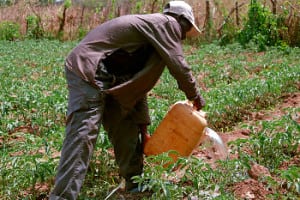
Watering and flooding fields by hand is simple, cheap and hard work, but leveling the field can help conserve water. Photo by Bread for the World / Flickr
Flood irrigation
Flooding fields with water from buckets or pumps is one of the simplest methods of irrigation. The advantage is that it requires little energy or equipment. Done improperly, however, it can waste water and erode and salinize the soil. To do it right, try three tricks that the US Geological Survey suggests:
*Time the floods to reduce runoff
*Catch the runoff in ponds or ditches at the edges of the field
*Level or grade the field with a gentle slope
Without accurate instruments, getting the land level or graded accurately can be a challenge. Farmers who don’t have a laser handy can try surveying their land with a DIY hose level. With little more than a hose, plastic tubes, stakes and measuring tape, the device measures the height difference between two points. Here’s a construction guide.
Depending on the crops planted, farmers may want to choose from among these types of flood irrigation, from a guide by the FAO:
*Basin *Furrow *Border
Buried clay pot irrigation
Unglazed clay pots buried at intervals in a field can water crops efficiently and drastically cut water consumption. When the pots are buried up to their openings and filled with water, the water seeps through the clay into the soil, drawn out at the rate at which the soil dries. The upshot is that the pots provide just the amount of water that the crops need. The video explains one method.
Drip irrigation
Drip irrigation is quickly gaining popularity as a low-cost and water-saving technique. At its core, it is a network of perforated tubes linked to a water source. The water flows through the tubes and trickles out of the perforations onto the soil. Many versions installed on small farms are gravity-driven, with the water stored in a tank raised above the farm so the water can flow through the tubes below.
Variations abound. A handful of organizations have refined and simplified the hardware to reduce costs. Notably, among its contingent of acclaimed designs, iDE, has developed a low-cost drip system explained in detail in this technical manual (pdf).
Drip system innovators
E4C’s Solutions Library search results for “drip irrigation”
DripTech
EOS
Solar drip
The Solar Electric Light Fund, based in Washington, DC, has installed award-winning solar-powered drip irrigation systems in Benin, West Africa. The systems use solar panels to power electric pumps that move water from the source to the field. Farming families in Benin have used the systems to boost crop yields and earn more money, SELF says. Stanford researchers involved with the organization published this paper (pdf) on the pumps in the journal PNAS.
Sprinklers
Sprinklers are sometimes derided as water wasters, but like flood irrigation, if done right, they can be efficient on small farms. IDE recommends sprinklers for closely spced crops such as wheat and rice in areas where water is too scarce for flooding fields.
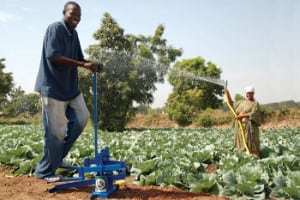
Photo by KickStart
Treadle pumps
Part of the challenge of irrigation is often how to draw water from a well or a nearby stream to the field. Diesel pumps are expensive, but fortunately, people have been pumping water since long before the advent of the diesel engine. Low-cost, human-powered designs are at work on farms worldwide. Farmers bobbing up and down in their fields on a machine that looks like a stair stepper are treadle-pumping water onto their crops. The pumps use leg power to move pistons and create suction that draws water through a hose from a well, a stream or another source. Some are compact, steel machines and others are handmade with treadles cut from local woods such as bamboo and other materials. Kickstart is one of the noteworthy organizations that design and sell these pumps. Kickstart’s pumps cost $35-100, depending on the region. And, the organization says, the pumps can help small-plot farmers earn an average of $1000 more per year.
Treadle pump innovators
Kickstart
iDE
Modular treadle pumps
The BYU team behind the human-powered water well drill has created a modular treadle pump. The device allows farmers on a tight budget to buy a hand pump and then pay for upgrades over time. The first upgrade available converts the hand pump into a treadle pump, and the second upgrade adds a second cylinder to the treadle pump and lengthens the treadles. Farmers can pay for more irrigating power as they earn money from their investments.
Rope pumps
This ancient technology is still at work on farms and in water wells today. The pump is a wheel at the top, a tube in the water below and a long loop of cord with washers or some other kind of disc tied on at intervals. When the operator turns the wheel at the top, the cord snakes through the tube and the discs draw water upwards to an outlet. The video by Pump Aid shows an animation of the process.
Rope pump innovators
Pump Aid
iDE
Appropedia’s depth-adjustable rope pump
Practica Foundation
Akvo
Bicycle rope pumps
Linking a rope pump to bicycle parts boosts the pump’s efficiency and saves the operator’s arms. iDE is developing a low-cost pedal-powered design, but it’s the first that we’ve seen that might be manufactured. Designs we’ve found have been DIY, but if readers know of a manufactured product or a construction guide, please let us know in the comments below.
Thermal solar pumps
Solar steam pumps are an interesting concept with a handful of prototypes on fields now. They use solar thermal energy – just the heat of direct sunlight – to heat water and power a small steam engine. iDE and the Practica Foundation are developing designs.
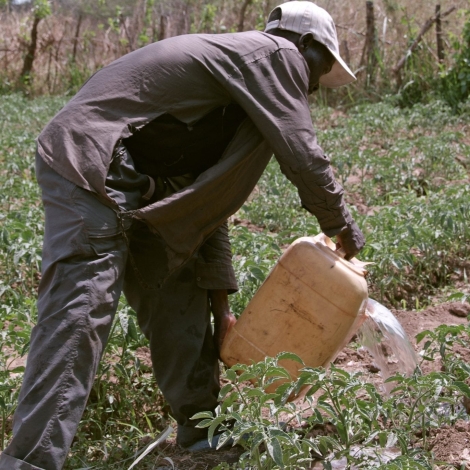
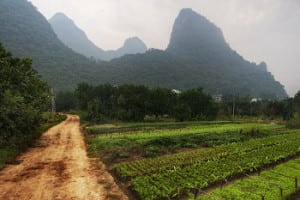
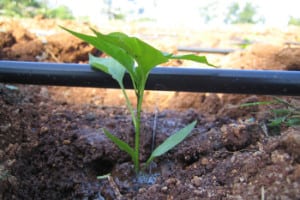
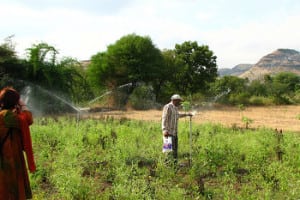
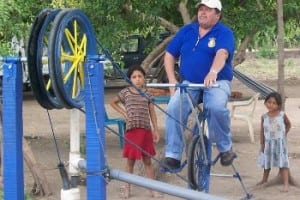
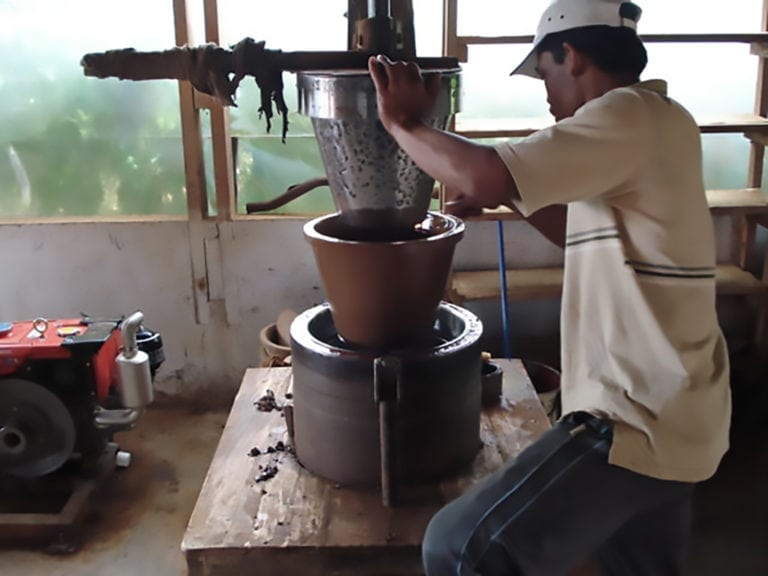
Great to visit this sites it ia really helpful regarding using of low cost technology to irrigate the farm.kindly share more sources of same for a small land holder who can easily adpot this one.
thanks
regrads
dushmanta
It’s so cool that there are so many options out there for irrigation pumps! I’m glad that there are options for people in poorer and more rural areas, that perhaps can’t afford a mechanical pump. Having the ability to draw up water at will would really improve the ability to maintain good agriculture in those areas.
I am interested in knowing about a simple water pump which can be used to lift water from a flowing canal without using electricity or diesel to irrigate land near the canal situated at some height from the level of water in canal.I would like to discuss this with u and the ur experts if you are interested.More than 20% land near canal is still unirrigation for this simple reason.Pl help. -Prakash Tekade
Hello,
If you want to go into irrigation farm business, There are so many company website this days like virtatrade.com that will enable you as a beginner to raise the fund you need to start up your irrigation farm business without you seeking for a loan.
This company is where many business dealers from all over the world generate fund that backup their various businesses financially.
I used this company to backup my cocoa beans export business each time am running loss financially.